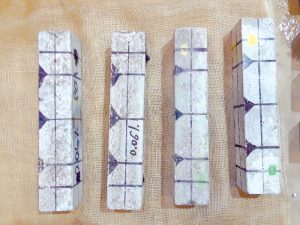Humans have been building with biology for thousands of years. Dimensional lumber and mass timber are mature technologies based on materials produced using biological processes. Today, there is fertile ground for additional research and development of materials based on biological processes or biomimetic principles finding application in structural engineering. Advancements in biotechnology are giving rise to new biomaterials for construction that go beyond wood; bioinspired structures and biomimicry are potential tools to augment existing and entirely new structures. The term biomimicry is derived from the words bios and mimicry coming from the Greek language meaning life and imitation, respectively. The fundamental tenet of biomimicry is to mimic nature and leverage the biological principles that have resulted from evolutionary processes.
In addition to trees, microorganisms play a key role in inspiring many new materials and structures of the future. For example, biomineralization is a process by which bacteria precipitate calcite, a hard mineral that is the most stable polymorph of calcium carbonate. Certain strains of microorganisms precipitate calcite when exposed to solutions that include calcium. These strains have been added to sand to create concrete-like alternatives. Compressive strengths of these bioinspired, biocemented bricks rival those of other cementitious materials. The major advantage to these biologically cemented sandstone bricks is their lower embodied energy and embodied carbon, as well as their autonomous nature of fabrication.

Microorganisms have also inspired new approaches to engineering durable infrastructure. For example, a common issue encountered by engineers and construction professionals is the harmful impact of freezing and thawing on concrete durability. A bioinspired solution to this issue is currently being researched at the University of Colorado Boulder. Synthetic polymers that mimic the ice recrystallization inhibition behavior of antifreeze proteins in certain plant and animal species are being added to concrete in place of air entrainment. Antifreeze proteins exist in plant and animal species that must survive in cold climates. Although beneficial to the durability of concrete structures, air entrainment includes some drawbacks, such as reductions in compressive strength, increases in chloride permeability, and inconsistencies in achieving sufficient air void systems in the field. As with many burgeoning technologies, the long-term behavior of biomimetic antifreeze polymers has not yet been investigated. Further research into biomimetic antifreeze polymers may yield a commercially viable bioinspired alternative to air entrainment.
Applications of bioinspired design can span multiple scales. For instance, subterranean tunnels that ant colonies produce are currently being studied at the California Institute of Technology. Their relative complexity and longevity make them interesting and particularly suitable for advanced geotechnical engineering applications. These ant tunnels can extend up to 25 feet below ground and last for decades. This research aims to determine how to emulate and scale these ant tunnels to a degree suitable for human applications in construction and determine the social mechanisms behind how the individual ants communicate to build their structures. This bioinspired research has implications in foundation engineering, including new possibilities ranging from deep foundation types to mechanically stabilized soil retaining wall structures.
Bioinspired engineering design of built infrastructure is an emerging field with a wide variety of future applications. Advances in biomimetic design will include concepts such as designing biological systems using computational algorithms to model biological processes and optimize the topology of structural systems. For example, structural materials researchers are already working with synthetic biologists to specifically design engineered strains of bacteria that are more efficient at producing calcite or engineered proteins. These products could serve a wide range of functions in augmenting or replacing conventional civil engineering materials. However, this type of biological design will require structural engineers to embrace interdisciplinary concepts, strategies, and methodologies – something that current civil and structural engineering curricula within conventional university degree programs do not easily enable.
While technical and curricular challenges still need to be overcome, possibilities abound within the emerging field of bioinspired structural engineering. Interested students and practitioners should seek out opportunities for bioinspired innovation and connect with the ASCE Bioinspired Structures committee, which is devoted to advancing innovations at the intersection of biomimicry and structural engineering. The chairperson of this committee is Dr. Hongyu (Nick) Zhou, an Assistant Professor in the Department of Civil and Environmental Engineering at the University of Tennessee in Knoxville. He can be reached by email at hzhou8@utk.edu.■
References
Bernardi, D., DeJong, J. T., Montoya, B. M., and Martinez, B. C. (2014). Bio-bricks: Biologically cemented sandstone bricks. Construction and Building Materials, 55, 462-469. https://doi.org/10.1016/j.conbuildmat.2014.01.019
Dade-Robertson, M., Guyet, A., Mitrani, H., Wipat, A., and Zhang, M. (2017). Synthetic Biological Construction: Beyond “bio-inspired” in the design of new materials and fabrication systems. 3rd International Conference Biodigital: Architecture & Genetics Conference Proceedings, 292-301.
Frazier, S. D., Matar, M. G., Osio-Norgaard, J., Aday, A. N., Delesky, E. A., and Srubar III, W. V. (2020). Inhibiting freeze-thaw damage in cement paste and concrete by mimicking nature’s antifreeze. Cell Reports Physical Science, 1(6), 100060.
Velasco, E. (2021, August 23). The Science of Underground Kingdoms. California Institute of Technology. www.caltech.edu/about/news/the-science-of-underground-kingdoms
